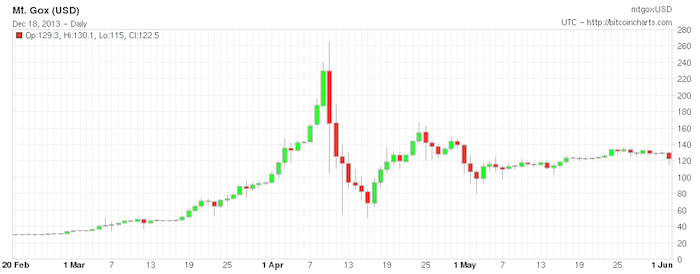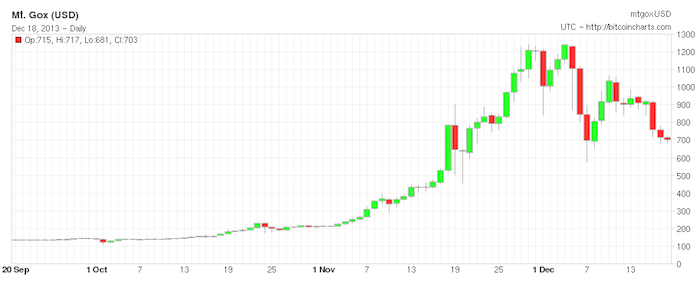The increasingly buffoonish establishment stooges at Business Insider are providing a platform for a Cathedral sanctioned expert, a finance professor, who is predicting a Bitcoin crash to below $10 by mid-2014.
I guess it’s to be expected that the opponents of Bitcoin would take advantage of recent price declines to slander Bitcoin and do their best to scare the shit out of insecure investors. It’s important to remember that we are in a war of perception here and that The Establishment is going to use all the weapons at its disposal to convince the undecided that Bitcoin is evil, dangerous, and destined for failure. Let’s unpack some of the good Professor’s arguments to see if he’s made any legitimate points we might address.
And from January to December 2013, markets obeyed with prices rising over 8,000 percent. In the mist of this hype, it appeared that the Bitcoin Revolution was on its way to transforming the economy, putting central bankers out of work and minting new e-currency millionaires daily. Bitcoin was priced for perfection. This past week, however, the market didn’t stick to the script. Instead it began to challenge the rhetoric, knocking prices down as low as $535, a drop of about 55 percent from recent highs. The market has finally realized that hype alone cannot support lofty prices. Bitcoin is not a legitimate currency but simply a risky virtual commodity bet.
Well, I can agree with him on one thing. Bitcoin is not a legitimate currency. Yet. The first thing you’ll notice about the opponents of Bitcoin is that they examine the properties of Bitcoin in it’s present state and then assume they will remain in perpetual stasis. Bitcoin is immature as a technology and as a financial instrument. Remember how crappy the internet was in 1990? Of course it isn’t ready to take over world reserve currency duties today. I don’t think anyone ever said it was. Over the coming years the system will mature, the Bitcoin protocol will be better understood, and the market will determine Bitcoin’s place in the financial universe.
We should also note that despite the 55% price declines mentioned in the article, Bitcoin has still grown by 550% over the past 6 months. If you compare the recent price action to the peak of March 2013, it seems likely that exuberance has cooled and the BTC market is searching for a new, substantially higher, baseline.

Above we have a graph of the March 2013 peak. Notice the accelerating increase, the decline, and the eventual stabilization at a significantly higher level. All in all, prices started at $40 and rose to $120, with a ton of action in between. Problems arise when you try to extrapolate future pricing based on price movement during violent up and down swings. If the “bubble” trend had continued we’d be over $100,000 by now. If the “crash” trend had continued the price would have hit $0 in April. But of course it didn’t. It never does. This is just how markets work. The herd works itself into a frenzy either buying or selling, but eventually the mania subsides and prices stabilize.
Now let’s compare to a chart of the recent price action.
Here we see a similar a pattern. A steep run up followed by a sharp decline and a period of stabilization. What the good Professor is trying to do is convince you that the recent sell off is a permanent trend, when in actuality it is already over or nearly over. Of course it’s possible that the price of BTC craters down to zero from here on out as the Professor predicts, but nothing has fundamentally changed to destroy the long term viability of the Bitcoin network or protocol. It seems much more likely that the price will stabilize somewhere between 500 and 800 and trade in a tight range for some time before the next major upward movement.
The next attack mounted by the Professor is on Bitcoin’s allegedly “flawed DNA”:
Since inception, Bitcoin has had a flawed DNA. It was dreamed up in a virtual world — by computer geeks — but was to be applied in the real world. Bitcoin is steep in Libertarian and anti-Fed dogma but weak in understanding of how global economics, central banking policies and financial markets function. The lifeblood of the global capital markets is money – greenbacks — transactional currency that facilitates commerce. Virtual currency can create value and efficiency but it needs to be linked to fiscal and monetary policy. To assume currency can be computer generated, run in a decentralized manner and outside of the central banking system and controls is farcical and economically dangerous.
In this passage the Professor states his allegiances plainly. He is a shill for the central banking system. He is not here to analyze Bitcoin, and it is clear from his writings that he knows very little about it. All he seems to know is that it is very very bad. It was “dreamed up in a virtual world” by “computer geeks” just like those others nightmares, Google, Facebook, and basically every other positive economic development of the past 30 years. It is “weak in understanding of how global economic works”.
I hate to break this to the Professor, but Bitcoin is computer software, and unless there is some type of artificial intelligence layer built in to contemplate “how global economics works”, it doesn’t know jack shit about global economics. Bitcoin is a machine that was built to do a job, facilitate financial transactions between people without need of a third party, and it does this job remarkably well. No understanding of “how global economics works” is required or desired for completion of this task.
I think what bugs the Professor so much is that Bitcoin doesn’t give a hoot what his benefactors, the central banking establishment, thinks or says. It does not bow down to their expertise and largesse. It is not grateful for the careful stewardship they have provided us over that past few decades, which have been so blissfully free of financial disasters.
Next, the Professor admits that “virtual currency can create value and efficiency”. He actually had me nodding my head for a second there before adding the totally unsubstantiated caveat that it needs “to be linked to fiscal and government policy”. By this he means that Bitcoin needs to be under central bank control. He then comes in with the knock out blow, that a computer generated decentralized currency is “farcical and economically dangerous”. Sadly, he does not provided the slightest rational argument for why this is so. I can only assume it is because it is dangerous to the economic interests and oversized egos of central bankers.
For currency to be adopted as a medium of exchange there has to be trust in the ability to honor the underlying obligation and the ability for central banking policy to control inflation. Historically the Fed has done a remarkable job maintain an average inflation rate of no greater than 2.5 percent. Given that two-thirds of U.S. GDP is driven by consumption, price stability in currency is essential. Without it, GDP growth is retarded and standard of living shrinks.
In this passage he makes some claims about the great skill of the central bankers to control inflation. I don’t even know if this is actually true, but if so, good for them. It is completely irrelevant. Bitcoin does not care what the US dollar does or how much it inflates. Regardless of what happens with Bitcoin, the Fed will remain free to inflate the dollar to its heart’s content. I have absolutely no idea how he makes the next leap to GDP being driven by consumption and how if it is retarded “standard of living shrinks” but I can only assume he was out of ideas and forced to resort to ham-handed scare tactics. This statement amounts to franticly screaming “You’re gonna be poor!!!!! Because Bitcoin is evil!!!!”.
To be honest, there is just too much bullshit in this article to deal with. I could address the other points, and maybe I will if there is demand for it, but none of it is actually deserving of criticism. I don’t have the time to go through line by line and point out that all of his arguments are based on the faulty assumption that the Central Banking Establishment needs total control to ensure that poor helpless consumers don’t hurt themselves with the dangerous bitcoins.
He rails against the volatility of Bitcoin which shows once again that he has no concept of what Bitcoin is or the inherently volatile nature of new technological developments. All disruptive technologies experience high volatility during their adolescent periods as it is determined if there is a market for their value proposition, and if there is, how big that market actually is. He even tosses out a Litecoin reference, as if it is somehow an immediate threat to displace Bitoin that market participants are unaware of. This would be more compelling if the Professor mentioned at least one technical or economic reason why Litecoin is an imminent threat.
Lastly, he predicts that “new regulations will be imposed and prices will plummet”. On this point, I cannot disagree. Bitcoin will continue to experience occasional crashes. It has from its inception in 2009. What the Professor neglects to mention is that if the four year trend persists, these crashes will be more than compensated for by explosive upswings.
The truth is, what makes the Professor so anti-Bitcoin and what he will never dare to mention, is that Bitcoin is displaying the S-curve of exponential growth common to all widely adopted network technologies and this makes his friends in central banking very very nervous.
